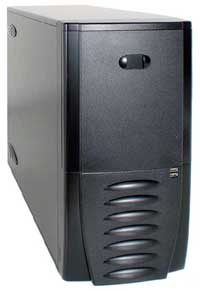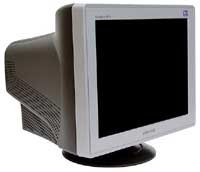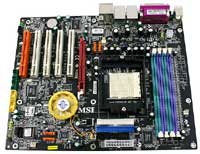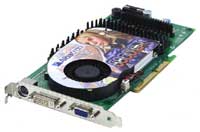AMD Mid-Range Gaming System
If you want some more
oomph in your system - say you like higher resolutions and antialiasing, or maybe you're a competitive online gamer - you could upgrade a few parts in the Budget System and end up with acceptable performance. We're going to kick it up another notch for the Mid-Range segment by improving nearly every component.
| Mid-Range AMD Athlon 64 System |
| Hardware |
Recommended Component |
Price |
| Processor |
AMD Athlon 64 3500+ 512K 2.2 GHz (939) 90nm |
285 |
| Motherboard |
MSI K8N Neo2 Platinum |
131 |
| Memory |
Mushkin Dual Pack 2x512 PC3200 2.5-3-3 |
159 |
| Video Card |
Albatron GeFORCE 6800 GT 256MB GDDR3 |
374 |
| Hard Drive |
Seagate 160GB SATA 7200RPM 8MB Model ST3160023AS |
93 |
| Optical Drive |
NEC DVD+/-RW Drive Model 3500A |
72 |
| Case and Power Supply |
Antec SLK3700-BQE with 350W |
91 |
| Display |
Samsung SyncMaster 997DF 19 CRT |
234 |
| Speakers |
Logitech Z-640 5.1 |
52 |
| Keyboard |
Logitech Internet Keyboard |
17 |
| Mouse |
Microsoft IntelliMouse Optical |
24 |
| Bottom Line |
|
1532 |

Click to enlarge. |
We return to several components that we have recommended in the past for the Mid-Range system. We've doubled the amount of RAM, and we've upgraded the case and PSU to the Antec SLK3700-BQE. It's not a flashy case, so if you're interested in that, you might look elsewhere. Nevertheless, it is a well thought out design, and the use of dual 120mm fans provides ample cooling when you add in the front fan. For the monitor, we have upgraded to a 19" CRT, which has the ability to run at 1600x1200 with a 75 Hz refresh rate. The NEC FE991SB is also an option, although it costs $40 more. We have upgraded to a Serial ATA hard drive with 160GB storage capacity, again staying with Seagate and their five-year warranty. Most of the other base components remain the same, although we opted for the five-button Microsoft IntelliMouse Optical this time.

Click to enlarge. |
The major changes come in the selection of motherboard, CPU, and graphics card. This should come as no surprise, as we have already mentioned several times that these are the most important aspects of a gaming system. For the processor, we have upgraded to an Athlon 64 3500+. The raw clockspeed advantage is not that great, but our
initial tests of the 90nm parts show a slight performance increase relative to the older 130nm 3500+, particularly in games, and it also has better overclocking capabilities if you're interested in that. The power use of the 90 nm parts is also substantially lower than the 130 nm design. The total price increase is $20 relative to the 130nm part, so either one is fine. The motherboard that we have selected uses the NForce3 250 Ultra chipset, and it was also our Gold Editor's Choice in our
Socket 939 Motherboard Roundup. There are several socket 939 motherboards with similar features that use the VIA K8T800 Pro chipset, but we have stuck with the NVIDIA chipset as tests have shown that it has a slight performance advantage when used with an NVIDIA graphics card compared to boards using the VIA chipset. ATI boards do not incur any penalties either, should you choose to go that route. If you prefer the VIA based boards, the Abit AV8 and Asus A8V both received our Silver Editor's Choice.

Click to enlarge. |
Speaking of graphics, our recommendation goes to a GeForce 6800GT AGP model. With 16 pixel pipelines, a 350 MHz GPU core and 1 GHz GDDR3 RAM, it provides nearly twice the performance of the 9800 Pro and significantly more than the 6600GT as well. Performance doesn't vary much if at all between the various manufacturers, so we have selected the card that we could find for the lowest price. You could also look into spending a bit more for a BFG 6800GT OC model that comes factory overclocked or the Leadtek model with it's larger two-slot HSF, but otherwise there is not a whole lot to differentiate among the designs. For ATI lovers, the X800 Pro actually offers very similar performance to the 6800GT. It only has 12 pixel pipelines, but since they're clocked at 475 MHz instead of 350 MHz, it ends up as almost a tie. The 6800GT has faster RAM - 1 GHz compared to 900 MHz - and it also includes Shader Model 3.0 support, not to mention a lower price. If you can find the X800 Pro for less than the 6800GT, though, it's definitely worth considering.

Click to enlarge. |
Then again, the AGP socket could become something of a limitation for upgrades by that time. We have recently previewed the
NForce 4 chipset as well as
ATI's RX480. Both should be available for purchase before the end of the year, and the NVIDIA boards will likely start showing up by the end of this month. If you're considering a socket 939 platform, and assuming you're willing to pay the price premium, it could be worth waiting for the PCI Express motherboards to ship. We'll take a look at PCI Express costs with our Intel Mid-Range alternative. SLI is also a very attractive feature for those looking to buy one card now and upgrade later. All told, an SLI-capable system will probably cost about $100 more than an equivalent AGP setup, but with AGP you're stuck with one graphics card.














70 Comments
View All Comments
nghtdvl - Monday, November 22, 2004 - link
Good guide, thanks.I'm still waiting to see some NF4 boards before getting a new system, though. I'm hoping the Gigabyte GA-K8NXP-939 will perform well.
Glassmaster - Monday, November 22, 2004 - link
#7: The Gigabyte board isn't worth the trouble, if you really want an nForce 3 get the MSI K8N Neo2. There's a good reason why Anandtech isn't recommending the Gigabyte board.Jarred: Do you guys actually build and stress test these systems? Over at the offical AMD Athlon 64 troubleshooting forums, the most common problem we see is weak power supplys without enough amps on the 12V rail causing stability issues or even failing to POST. We generally recommend only PSUs with at least 18-20A on the 12V rail for the Athlon 64. I tried to look up the specs on that generic 350W PSU, but was unable to find them. Even the 350W Antec is difficult to find specs for. I know you are trying to save money, but what about the Antec True Power 380W (18A on 12V rail) for low end, and Antec True Power 430W (26A on the 12V rail) for the mid-range?
Glassmaster.
Brian23 - Monday, November 22, 2004 - link
I like the fact that the guide reminds people that the price of SLI is too high for anyone but the most hardcore gamer.crazycarl - Monday, November 22, 2004 - link
i like the new format for the buyer's guides!bsrealm - Monday, November 22, 2004 - link
great guide, but i see there is no mention about RAIDing the SATA drives.. wouldnt that improve performance (atleast while installing and reading the game files)i am also a graphic designer and i guess while loading large files RAID would help..
and i agree with drpepper - video editors' guide please!!!
xsilver - Monday, November 22, 2004 - link
thanks jarred -- im just laughing to see the same situation as pci video cards -- I still see tnt2 pci go for $50 on ebay! -- what a joke.... I don't want to be one of those stuck with something that is going to cost more in the long run :)drpepper1280 - Sunday, November 21, 2004 - link
Thank you,This was the way buyers guiders were meant to be done. Now for one on video editing!
ariafrost - Sunday, November 21, 2004 - link
One thing that bothers me... the keyboards and mice listed are "decent", but if you are wanting the bleeding edge in gaming, WHY would you buy an Intellimouse? Get something better... like an MX510 at least...DEMO24 - Sunday, November 21, 2004 - link
Im not sure why the VP912b was listed instead of a Dell 2001fp. the 2001 is larger and has a larger resolution. true it costs more but this is a all out system.drifter106 - Sunday, November 21, 2004 - link
as you indicated it does come off somewhat different from the norm that I have seen in previous guides...but neverless thanks for the time and effort... it makes me consider possible alternatives for my upcoming buildoh yea... i'll check back tommorrow and see how many winers come thru...hehe